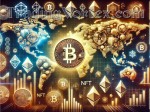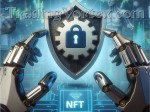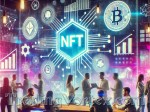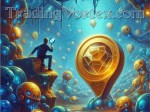Table Of Contents:
- Cross-Platform NFT Trading: The Future of Digital Asset Interoperability:
- What is Cross-Platform NFT Trading?
- Top Trends Shaping Cross-Platform NFT Trading in 2025:
- Major Challenges Facing Cross-Platform NFT Trading:
- Proven Strategies for Successful Cross-Platform NFT Trading:
- The Future of Cross-Platform NFT Trading: What to Expect?
- Final Thoughts – Navigating the Cross-Platform NFT Revolution:
- Frequently Asked Questions (FAQs) on Cross-Platform NFT Trading:
- Q1. What exactly is cross-platform NFT trading?
- Q2. How do I start trading NFTs across different platforms?
- Q3. Are there risks associated with cross-platform NFT trading?
- Q4. How can I ensure the security of my NFTs during cross-platform transactions?
- Q5. What are NFT swapping and bridging?
- Q6. How do I choose the right NFT marketplace for cross-platform trading?
- Q7. Are there any tax implications for trading NFTs across platforms?
- Q8. How can I stay updated on the latest trends in cross-platform NFT trading?
Cross-Platform NFT Trading: The Future of Digital Asset Interoperability:
Imagine a world where your digital collectibles aren't confined to a single platform, but can move freely across various digital landscapes. This isn't some far-off dream; it's the emerging reality of cross-platform NFT trading, and it's set to revolutionize the digital economy.
Why Cross-Platform NFT Trading is Revolutionizing the Digital Economy:
In the early days of NFTs, each token was typically tied to a specific blockchain, limiting its use and trade to that ecosystem. This siloed approach often felt like owning a rare baseball card but being allowed to trade it only within your neighborhood. Enter cross-platform NFT trading; a game-changer that breaks down these barriers, allowing NFTs to be transferred and utilized across multiple blockchains. This shift is akin to giving collectors access to a global marketplace, exponentially increasing the potential for trade and collaboration.
One of the most exciting aspects of this development is the enhancement of liquidity. When NFTs can be traded across various platforms, they're no longer restricted to the user base of a single marketplace. This broader accessibility can lead to more dynamic pricing and a more vibrant market overall. Think of it as opening up a local farmer's market to international buyers; the increased demand can significantly boost the value of the goods being sold.
Moreover, cross-platform interoperability fosters innovation. Developers are no longer constrained by the limitations of a single blockchain's capabilities. They can leverage the strengths of multiple platforms to create more robust and versatile applications. This flexibility is paving the way for NFTs that can be used in a variety of contexts, from gaming to real estate, without being tied down to one specific system.
Key Insights into This Article:
In this article, we'll delve deeper into how cross-platform NFT trading is reshaping the digital economy. We'll explore the technological advancements making this possible, the benefits and challenges associated with this new paradigm, and what it means for investors, developers, and everyday users. Whether you're a seasoned trader or just dipping your toes into the world of NFTs, understanding the implications of cross-platform trading is crucial for navigating the future of digital assets.
So, grab a cup of coffee, and let's embark on this journey together to uncover the future of digital asset interoperability.
What is Cross-Platform NFT Trading?
Alright, let's dive into the world of cross-platform NFT trading. If you've ever felt limited by the confines of a single blockchain when dealing with your digital assets, you're not alone. Many traders and investors share this sentiment. So, what exactly is cross-platform NFT trading, and why should you care? Let's break it down together.
Understanding the Concept of Trading NFTs Across Multiple Blockchains:
At its core, cross-platform NFT trading is about flexibility and freedom. Traditionally, NFTs (non-fungible tokens) were tied to a single blockchain, like Ethereum or Solana. This meant that if you owned a digital artwork on Ethereum, you couldn't easily sell or trade it on a Solana-based marketplace. It was as if you had a rare collectible that could only be sold in one specific store; frustrating, right?
Why Interoperability is the Backbone of the NFT Ecosystem:
Interoperability isn't just a fancy buzzword; it's the backbone of a thriving NFT ecosystem. When NFTs can operate across multiple blockchains, it enhances liquidity, accessibility, and innovation. Imagine being able to showcase your digital art in various virtual galleries, participate in multiple gaming universes with the same in-game assets, or trade collectibles across diverse marketplaces without a hitch. This interconnectedness fosters a more dynamic and inclusive digital economy.
Moreover, interoperability reduces the risks associated with being locked into a single platform. If one blockchain faces issues like high transaction fees or slow processing times, you can move your assets to another that better suits your needs. It's akin to having multiple bank accounts in different currencies, allowing you to choose the most favorable one for each transaction.
The Current Landscape: Where We Stand Today?
As of now, the NFT space is rapidly evolving, with significant strides being made toward cross-platform functionality. Projects and platforms are actively developing solutions to bridge the gaps between blockchains, making cross-chain NFT trading more accessible than ever.
For instance, cross-chain NFT marketplaces are emerging, allowing users to trade NFTs across different blockchain networks. These platforms utilize cross-communication bridges to facilitate seamless transactions, enhancing the flexibility and reach of digital assets.
However, it's not all smooth sailing. Challenges such as varying standards between blockchains, security concerns, and the complexity of implementing cross-chain functionality still exist. But with the pace of innovation and the collective effort of the community, the future looks promising.
In conclusion, cross-platform NFT trading is reshaping the digital asset landscape, offering unprecedented opportunities for traders and investors. By understanding its fundamentals and staying informed about ongoing developments, you can position yourself to take full advantage of this exciting evolution in the NFT ecosystem.
Top Trends Shaping Cross-Platform NFT Trading in 2025:
NFTs have evolved from a niche corner of the blockchain world into a dynamic, global marketplace for art, gaming assets, virtual real estate, and more. As the NFT ecosystem continues to mature, cross-platform trading is emerging as the next frontier. Here’s a look at the trends shaping this exciting new landscape, and why they matter for traders and investors at every level.
The Rise of Cross-Chain NFT Marketplaces:
Platforms like Magic Eden and OpenSea, which now support trading across Ethereum, Polygon, Solana, and more, are leading this charge. These marketplaces function as bridges, enabling NFTs to be bought, sold, and traded across different blockchain ecosystems without the need for complicated workarounds.
By 2025, these platforms are expected to go beyond basic trading functionality, offering enhanced features like real-time cross-chain price comparisons, seamless wallet integration, and support for emerging blockchains. This isn’t just a convenience upgrade: it’s a liquidity revolution. With more participants able to access NFTs from multiple blockchains, the market becomes more competitive, driving both prices and innovation upward.
Pro Tip for Traders: Keep an eye on emerging marketplaces that specialize in niche assets, like gaming NFTs or virtual real estate. These focused platforms are likely to gain traction in 2025, giving you early access to unique opportunities.
Multi-Chain Integration with Decentralized Exchanges (DEXs):
If centralized NFT marketplaces are the shopping malls of the crypto world, then decentralized exchanges (DEXs) are the bustling street markets: open, diverse, and brimming with possibilities. Platforms like Rarible and LooksRare have already started integrating multi-chain support, allowing users to trade NFTs across blockchains without centralized intermediaries.
This shift isn’t just about decentralization; it’s about empowerment. Multi-chain DEXs provide traders with greater control over their assets and enable them to bypass hefty fees often associated with centralized platforms. By 2025, we’re likely to see DEXs take a more active role in the NFT space, offering advanced tools like automated market-making (AMM) for NFTs, lending and borrowing against NFTs as collateral, and integrated analytics for pricing trends.
Why This Matters: For traders, the rise of DEXs means more transparency, lower fees, and faster transactions. For the ecosystem, it means greater decentralization and resilience – a win-win for everyone involved.
Breakthroughs in Interoperability Protocols:
Projects like LayerZero and Polkadot are spearheading this transformation. These protocols act as bridges, enabling data, tokens, and NFTs to flow freely between different blockchain ecosystems. By 2025, these solutions are expected to become more robust, supporting faster transactions, lower fees, and even greater security for cross-chain NFT transfers.
One particularly exciting development is the rise of standardized NFT metadata. Currently, different blockchains often use different formats for NFTs, which can complicate cross-chain trading. New interoperability protocols aim to standardize these formats, ensuring that your NFT looks and functions the same whether it’s on Ethereum, Binance Smart Chain, or any other network.
What This Means for Traders: Interoperability is more than just a technical buzzword: it’s the foundation of a truly global NFT economy. As protocols evolve, expect to see more frictionless trading, easier asset migration, and fewer technical hurdles for everyday users.
Emerging Innovations: Look out for new marketplaces and tools that leverage these protocols to offer unique features, like fractionalized NFTs (allowing multiple owners of a single asset) or dynamic NFTs that can change over time. These cutting-edge applications could redefine what it means to own and trade digital assets.
Why These Trends Matter?
The NFT market in 2025 is shaping up to be more accessible, dynamic, and interconnected than ever before. For traders and investors, this means more opportunities to diversify portfolios, capitalize on emerging markets, and navigate a rapidly evolving ecosystem.
As we move into this new era of cross-platform NFT trading, staying informed about these trends is essential. Whether you’re buying your first NFT or managing a portfolio of digital assets, understanding the tools and platforms available will give you a competitive edge.
The future of NFTs isn’t just about owning cool digital art or gaming skins; it’s about participating in a borderless, decentralized economy where creativity and commerce intersect. And that’s a future worth getting excited about.
Major Challenges Facing Cross-Platform NFT Trading:
Cross-platform NFT trading has opened up new possibilities, but like any groundbreaking innovation, it comes with its fair share of challenges. Think of it as trying to build a highway system that connects multiple cities: exciting, but fraught with bottlenecks, safety concerns, and regulatory red tape. Here’s a closer look at the hurdles traders face and how the industry is working to overcome them.
Scalability – The Bottleneck in Cross-Platform Transactions:
Let’s face it: nobody likes waiting. Whether it’s for a coffee order or a blockchain transaction, delays can be frustrating. Unfortunately, scalability remains one of the biggest obstacles for cross-platform NFT trading.
How Congested Networks and High Fees Affect Traders:
Scalability isn’t just about speed; it’s about accessibility. If transactions remain expensive and slow, it creates an uneven playing field where only big spenders can thrive, leaving casual collectors and smaller investors out of the game.
Emerging Solutions to Scale NFT Trading:
The good news? Developers are hard at work addressing these bottlenecks. Layer 2 scaling solutions like Arbitrum, Optimism, and Polygon are stepping up to reduce costs and improve transaction speeds by processing transactions off-chain before settling them on the main blockchain.
Another promising approach is the use of sidechains: separate blockchains connected to a parent blockchain, like Ethereum. Platforms like Immutable X and Ronin are pioneering this space, offering faster, cheaper transactions without compromising security.
Additionally, innovations in sharding (dividing blockchains into smaller segments to handle more transactions simultaneously) could provide the breakthrough needed to ensure smooth cross-platform trading. For traders, these developments mean a future where blockchain congestion is a thing of the past.
Security Risks in Cross-Chain NFT Transactions:
Cross-chain trading is exciting, but let’s be real: it can feel like venturing into uncharted territory where you’re not sure what’s lurking around the corner. Security remains a top concern, and for good reason.
What Makes Cross-Platform Trades Vulnerable?
Cross-chain transactions involve multiple protocols, smart contracts, and bridges, all potential points of failure. A single vulnerability in a bridge or an exploited smart contract can lead to devastating losses. Take the $600 million hack of Axie Infinity’s Ronin Bridge in 2022 as an example; it shook the confidence of traders across the NFT ecosystem.
Phishing attacks, fake marketplaces, and compromised wallets also pose threats, making it crucial for traders to remain vigilant when navigating cross-platform trades.
Best Practices to Secure Your Assets:
The good news is that you can take steps to protect yourself. Here’s what seasoned traders swear by:
- Stick to Trusted Marketplaces: Platforms like OpenSea, Magic Eden, and Rarible invest heavily in security, making them safer choices for cross-chain trades.
- Enable Multi-Factor Authentication (MFA): Adding an extra layer of security to your accounts can significantly reduce the risk of unauthorized access.
- Invest in a Hardware Wallet: Hardware wallets like Ledger or Trezor keep your assets offline, making them immune to online hacks.
- Stay Updated: Keep an eye on security news and updates for the platforms you use; knowledge is your best defense.
Regulatory Uncertainty in the NFT Space:
Let’s be honest: nobody likes legal gray areas, especially when they can impact your wallet. Regulatory uncertainty is a big challenge for NFT trading, and it’s not going away anytime soon.
How Legal Ambiguities Impact Cross-Platform Trading:
Right now, there’s no universal agreement on how NFTs should be classified. Are they digital art? Securities? Commodities? The answer varies depending on the country, and even within countries, regulations can be murky. This lack of clarity leaves traders in a precarious position, with potential tax implications, compliance risks, or even legal consequences for seemingly straightforward transactions.
The recent scrutiny of NFT marketplaces by the U.S. Securities and Exchange Commission (SEC) is a wake-up call for the industry. In 2024, OpenSea faced a legal battle over whether certain NFTs could be considered investment contracts, potentially subject to securities laws. Events like this highlight the need for clear guidelines that both traders and platforms can rely on.
The Need for Clear and Unified Guidelines:
For the NFT ecosystem to thrive, regulators need to establish cohesive, fair rules that protect users without stifling innovation. Industry groups and blockchain alliances are actively lobbying for more defined regulations, while some countries are taking proactive steps. For instance, Japan has introduced specific rules for digital assets, setting an example for others to follow.
For traders, staying informed about the regulatory landscape is non-negotiable. Keeping detailed records of transactions, consulting tax professionals, and using platforms with compliance measures can save you from future headaches.
Overcoming the Challenges – A Call to Action:
Yes, cross-platform NFT trading has its challenges, but every hurdle is an opportunity for growth. Scalability issues are driving technological innovation, security concerns are pushing for better protocols, and regulatory uncertainty is fostering important conversations about the future of digital assets.
For traders and investors, the key is to stay informed, embrace new tools, and approach the market with both caution and curiosity. The road to seamless cross-platform NFT trading might still have a few bumps, but with the pace of innovation, we’re getting closer to a smoother ride every day.
Proven Strategies for Successful Cross-Platform NFT Trading:
Trading NFTs across platforms is a bit like juggling: it takes practice, strategy, and the right tools. Whether you’re a beginner dipping your toes into the NFT world or a seasoned trader looking to refine your approach, these proven strategies will help you take your cross-platform NFT trading game to the next level. Let’s break it down:
Build a Diversified NFT Portfolio Across Blockchains:
Why Diversification is Key in the Multi-Chain Era:
Each blockchain has its own set of strengths. Ethereum remains the king of NFTs, with a robust ecosystem and established artists. However, blockchains like Solana, Polygon, and Flow are offering lower transaction fees, faster speeds, and growing NFT communities. For example, Solana has gained attention for its speed and cost efficiency, making it a solid choice for traders looking for an alternative to Ethereum's congestion and gas fees.
By spreading your investments across blockchains, you increase your chances of riding the next big wave of an emerging market. A diversified portfolio can smooth out the volatility that often comes with NFTs on any single chain. It's like playing the stock market, but in the digital art and collectibles space: think of it as balancing your risk and reward.
Practical Steps to Diversify Smartly:
- Research Multiple Blockchains: Explore the major players, like Ethereum, Solana, Binance Smart Chain, and newer chains like Tezos or Flow. Understand their advantages, user base, and the specific NFT ecosystems flourishing on them.
- Invest in Different NFT Categories: Don't just focus on art – consider gaming assets, virtual real estate, and even music NFTs, which thrive on different blockchains.
- Engage with Communities: The community around a blockchain can give you insider info on upcoming projects. Join Discord servers and Telegram groups to stay ahead of trends.
- Monitor and Adjust: Keep a close eye on your portfolio. Some chains may outperform others, and you can adjust your investments accordingly.
Leverage Multi-Chain Wallets for Streamlined Trading:
The Best Multi-Chain Wallets for 2025:
As the NFT space continues to evolve, so do the tools traders need to navigate it. Enter multi-chain wallets, which simplify the process of holding and transferring NFTs across different blockchains. These wallets allow you to manage assets from multiple chains in one place, making your life a whole lot easier. In 2025, more wallet providers are stepping up their game, offering additional features and even better security.
Here are a few top multi-chain wallets to consider for smooth, seamless NFT trading:
- MetaMask: A staple for Ethereum and EVM-compatible chains, MetaMask is trusted by many in the NFT space. It’s lightweight, user-friendly, and continues to evolve with features that streamline NFT transfers and transactions.
- Trust Wallet: With support for over 100 blockchains, including Ethereum, Solana, and Binance Smart Chain, Trust Wallet is the Swiss Army knife of wallets. It also lets you swap tokens and buy NFTs with ease.
- Exodus Wallet: A favorite for its desktop and mobile app integration, Exodus supports a wide range of assets and offers seamless in-app swaps, making it a strong contender for cross-platform NFT trading.
- Bitget Wallet: A standout in the multi-chain space, Bitget allows users to trade across various DEXs and NFT markets, aggregating liquidity and simplifying transactions for traders on different chains.
Features to Look For When Choosing Your Wallet:
- Multi-Chain Compatibility: Ensure the wallet supports the blockchains you plan to trade on. Look for those that can handle Ethereum, Solana, Binance Smart Chain, and any emerging chains you're interested in.
- Intuitive UI/UX: Choose a wallet with a clean and easy-to-navigate interface, particularly if you’re new to NFTs.
- Security Protocols: Look for advanced security features like two-factor authentication (2FA) and the option for self-custody of your private keys. The more control you have over your assets, the safer they’ll be.
- Cross-Platform Integration: Some wallets offer more seamless integrations with marketplaces, making it easier to list, buy, and sell NFTs directly from your wallet.
Stay Ahead with Market-Specific Trends:
Tools and Resources to Track Market Insights:
NFT trading isn’t just about buying low and selling high: it’s about being in the right place at the right time. Staying informed about market trends is one of the most powerful strategies to maximize your profits. Whether you’re an artist, a collector, or an investor, tools and resources that provide market insights can help you make data-driven decisions that set you apart.
- NFT Marketplaces and Analytics Platforms: OpenSea, Rarible, and Foundation are not just places to buy and sell NFTs – they also offer valuable data on pricing trends, top creators, and rising NFT collections. Websites like CryptoSlam and DappRadar track NFT sales volumes, making it easy to spot which projects are booming and which are cooling down.
- Social Media & Community Insights: Keep an eye on NFT influencers, Twitter threads, and Discord communities. Social platforms are where early adopters and trendsetters often post updates about up-and-coming NFT drops or projects to watch. It’s a great way to gauge market sentiment and jump on trends early.
- News Outlets and Thought Leadership: NFTs are constantly in the news, from big acquisitions to celebrity involvement. Staying updated with outlets like The Block, CoinDesk, and NFT Now can help you understand the big picture and spot emerging trends.
How to Use Analytics to Inform Your Trades:
- Track Rarity and Popularity: The rarity of an NFT and its associated demand often determine its value. Use platforms like Rarity Tools and NFT Stats to assess the scarcity of specific items within a collection. The more rare and desirable an NFT is, the higher the potential resale value.
- Monitor Market Sentiment: Analyzing the community’s mood through social media and discussions can give you a sense of whether the market is hot or cooling down. Sentiment analysis tools like LunarCrush provide insights into community engagement, helping you predict the next big trend.
- Evaluate Project Health: Look at a project’s roadmap, the team behind it, and their community engagement. Projects with active roadmaps and consistent communication with their audience tend to do better long term.
Cross-platform NFT trading is more than just a trend: it’s a fundamental shift in how we think about ownership and value in the digital world. By building a diversified portfolio, choosing the right multi-chain wallets, and staying informed about market trends, you’ll be equipped to navigate this exciting space with confidence. So, get ready – the world of NFTs is waiting, and there are countless opportunities to explore.
The Future of Cross-Platform NFT Trading: What to Expect?
If you thought the NFT world was a rollercoaster in 2024, buckle up – 2025 is shaping up to be a thrilling ride. The cross-platform NFT trading landscape is evolving rapidly, with new technologies and market dynamics set to redefine how we buy, sell, and interact with digital assets. Let's dive into what the future holds and how you can stay ahead of the curve.
Market Growth Predictions for the Next Decade:
Insights Into the Rapid Expansion of the Cross-Platform NFT Market:
The NFT market is on an upward trajectory, with projections indicating substantial growth in the coming years. By 2025, the global NFT market is expected to reach approximately $2.88 billion, with a compound annual growth rate (CAGR) of 5.40% from 2025 to 2028.
This growth is driven by increased adoption across various industries, including art, gaming, and real estate. For instance, the virtual real estate market within the metaverse is projected to grow by 50% annually, highlighting the expanding role of NFTs in digital ownership.
What Investors and Traders Can Prepare For:
As the market expands, expect:
- Diversified Investment Opportunities: NFTs will continue to diversify beyond digital art into sectors like gaming assets, virtual real estate, and tokenized physical assets.
- Increased Institutional Participation: More traditional financial institutions are likely to enter the NFT space, bringing with them greater liquidity and market stability.
- Enhanced Regulatory Frameworks: Anticipate clearer regulations that will provide a more secure environment for trading and investing in NFTs.
Emerging Technologies Shaping the Next Phase:
How AI, Automation, and Blockchain Innovation Will Transform NFT Trading:
The integration of advanced technologies is set to revolutionize NFT trading:
- Artificial Intelligence (AI): AI is enhancing market analysis, improving security, and streamlining user experiences. For example, AI-powered smart contracts are automating transactions and enhancing security in Web 3.0 ecosystems.
- Blockchain Enhancements: Innovations in blockchain technology are increasing transaction speeds and reducing costs, making cross-platform NFT trading more efficient. The integration of AI with blockchain ensures data security and transparency, providing a robust foundation for NFT transactions.
- Decentralized Finance (DeFi) Integrations: The fusion of NFTs with DeFi platforms is creating new financial products and services, offering traders innovative ways to leverage their digital assets.
Upcoming Innovations That Will Enhance User Experience:
- AI-Powered Marketplaces: Platforms utilizing AI will offer personalized recommendations and predictive analytics, helping traders make informed decisions.
- Enhanced Interoperability: Advancements in blockchain technology will enable seamless cross-chain transactions, allowing NFTs to move freely between different platforms and blockchains.
- Improved User Interfaces: Expect more intuitive and user-friendly interfaces, making NFT trading accessible to a broader audience, including those new to the space.
Conclusion: The future of cross-platform NFT trading is bright and brimming with opportunities. By staying informed about market trends and technological advancements, you can position yourself to navigate this dynamic landscape successfully. Remember, in the world of NFTs, adaptability and continuous learning are your best allies. So, keep your eyes on the horizon – exciting times are ahead!
Final Thoughts – Navigating the Cross-Platform NFT Revolution:
As we wrap up our deep dive into cross-platform NFT trading, let's take a moment to reflect on the key takeaways and look ahead to the future of digital assets.
Key Takeaways from Trends, Challenges, and Strategies:
- Market Evolution: NFTs have evolved from speculative assets to integral components of the digital economy, impacting industries like art, gaming, and real estate.
- Diversification is Crucial: Building a diversified NFT portfolio across multiple blockchains can help mitigate risks and capitalize on various market opportunities.
- Embrace Technology: Leveraging multi-chain wallets and staying informed about emerging technologies like AI and blockchain innovations can enhance your trading experience.
- Stay Informed: Keeping up with market-specific trends and utilizing analytics tools can provide valuable insights to inform your trading decisions.
Why Cross-Platform NFT Trading is the Future of Digital Assets:
The future of digital assets is undeniably cross-platform NFT trading. As the market continues to grow and diversify, the ability to seamlessly trade NFTs across various platforms and blockchains will be essential. This interoperability not only enhances liquidity but also opens up a world of possibilities for creators and collectors alike.
In the coming years, we can expect to see more specialized NFT platforms catering to specific niches, offering curated experiences and services to dedicated communities.
Additionally, the integration of advanced technologies like AI and blockchain enhancements will streamline trading processes, making them more efficient and user-friendly.
In conclusion, navigating the cross-platform NFT revolution requires adaptability, continuous learning, and a proactive approach to embracing new technologies and market trends. By staying informed and strategically positioning yourself, you can thrive in this dynamic and exciting space.
Frequently Asked Questions (FAQs) on Cross-Platform NFT Trading:
Welcome to the world of cross-platform NFT trading! Whether you're a seasoned trader or just dipping your toes into the NFT waters, we've got you covered. Let's tackle some of the most common questions to help you navigate this exciting space.
Q1. What exactly is cross-platform NFT trading?
Cross-platform NFT trading involves buying, selling, or exchanging non-fungible tokens (NFTs) across different blockchain networks. This means you can move your digital assets from one platform to another, enhancing liquidity and market reach. For instance, you might transfer an NFT from Ethereum to Solana to tap into a different community or benefit from lower transaction fees.
Q2. How do I start trading NFTs across different platforms?
To embark on cross-platform NFT trading, follow these steps:
⇒ Set Up a Multi-Chain Wallet: Choose a wallet that supports multiple blockchains, such as MetaMask or Phantom. This allows you to manage assets across various networks seamlessly.
⇒ Fund Your Wallet: Deposit the necessary cryptocurrencies into your wallet to cover transaction fees and purchases.
⇒ Explore NFT Marketplaces: Platforms like OpenSea, Magic Eden, and Rarible support NFTs across different blockchains. Browse, buy, and sell NFTs that interest you.
⇒ Engage in Cross-Chain Transactions: Utilize bridging services to transfer NFTs between blockchains, expanding your trading opportunities.
Q3. Are there risks associated with cross-platform NFT trading?
Absolutely. While cross-platform trading offers numerous benefits, it's essential to be aware of potential risks:
⇒ Security Concerns: Transferring NFTs between blockchains can expose you to vulnerabilities. Always use reputable platforms and double-check transaction details.
⇒ Transaction Fees: Some blockchains have high gas fees, which can eat into your profits. Be mindful of these costs when trading.
⇒ Market Volatility: NFT values can fluctuate rapidly. Stay informed about market trends to make educated decisions.
Q4. How can I ensure the security of my NFTs during cross-platform transactions?
To protect your digital assets:
⇒ Use Trusted Platforms: Engage with well-established marketplaces and bridging services known for their security measures.
⇒ Enable Two-Factor Authentication (2FA): Add an extra layer of security to your accounts.
⇒ Verify Transactions: Always double-check transaction details before confirming, especially when bridging NFTs between blockchains.
Q5. What are NFT swapping and bridging?
⇒ NFT Swapping: This allows users to exchange NFTs directly with each other, often without the need for a marketplace. It's a peer-to-peer method that can increase liquidity and offer more favorable terms.
⇒ NFT Bridging: This process involves transferring NFTs from one blockchain to another, enabling you to access different markets and communities. For example, moving an NFT from Ethereum to Solana can reduce transaction fees and open up new trading opportunities.
Q6. How do I choose the right NFT marketplace for cross-platform trading?
Consider the following factors:
⇒ Supported Blockchains: Ensure the marketplace supports the blockchains you're interested in.
⇒ User Experience: A user-friendly interface can make your trading experience smoother.
⇒ Community and Liquidity: A vibrant community and high liquidity can lead to better trading opportunities.
⇒ Fees: Compare transaction and listing fees across platforms to find the most cost-effective option.
Q7. Are there any tax implications for trading NFTs across platforms?
Yes, trading NFTs can have tax consequences. In many jurisdictions, profits from NFT sales are considered taxable income. It's crucial to keep detailed records of your transactions and consult with a tax professional to understand your obligations.
Q8. How can I stay updated on the latest trends in cross-platform NFT trading?
To stay informed:
⇒ Follow Industry News: Regularly read reputable sources like CoinDesk and The Block.
⇒ Join Communities: Participate in forums and social media groups related to NFTs.
⇒ Attend Webinars and Conferences: Engage with experts and fellow traders to gain insights.
Remember, the NFT space is dynamic and ever-evolving. Staying informed and continuously learning will help you navigate this exciting world with confidence. Happy trading!








































 TradingVortex.com® 2019 © All Rights Reserved.
TradingVortex.com® 2019 © All Rights Reserved.